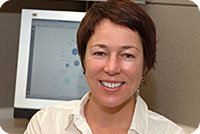 Jimena L. Davis, Ph.D. Jimena L. Davis, Ph.D.
Computational Mathematics, North Carolina State University
Cross ORD Postdoctoral Fellow, EPA’s National Center for Computational Toxicology
I enjoy collaborating with so many talented disciplinary scientists in NCCT in efforts that will address critical issues in human health. Being able to utilize and further develop my computational and analytical skills while working on interesting yet challenging biological applications that are essential to the health of others is very rewarding and what I enjoy most about my work.
Quantifying Uncertainty in Linked Exposure-to-Effects Models for Pyrethroid Pesticides
With the increased use of models in describing the metabolism and distribution of toxins in humans, quantifying the uncertainty in the estimates of unknown model parameters as well as model predictions has become an increasingly important yet complex task due to the various levels of uncertainty (e.g., uncertainty in parameter estimates and model extrapolations) that must be considered. Variability must also be accounted for accurately since some model parameters vary across individuals within a population. In an effort to provide better quantitative assessments of the effects of toxins on human health, we are working on the development of computational and statistical methodologies for quantifying the variability and uncertainty of predictions from linked quantitative models describing exposure, internal dose, and biological effects. The methodologies developed in this cross-disciplinary research project will be useful not only in the cumulative risk assessments for pyrethroid pesticides but will also provide better standards for future cumulative risk assessments.
 Holly M. Mortensen, Ph.D. Holly M. Mortensen, Ph.D.
Biology, University of Maryland, College Park
Cross ORD Postdoctoral Fellow, EPA’s National Center for Computational Toxicology
I enjoy using interdisciplinary approaches in solving complex biological problems with direct application to human health. I am inspired by working with the experts at the NCCT who are from very diverse scientific backgrounds, a composition that is essential in order to appropriately address complex human health issues.
The U.S. Environmental Protection Agency (EPA), through its ToxCast program, is developing predictive toxicity approaches that will use in vitro high-throughput screening (HTS), high-content screening (HCS) and toxicogenomic data to predict in vivo toxicity phenotypes. To help analyze the ToxCast data, which is generated from over 600 different assays, we are developing a platform to infer predictive toxicological signatures. Among other features, this platform will provide a visually intuitive representation, using network inference, of quantitative chemical effects across multiple levels of biological organization, including relationships to in vivo toxicity endpoints. We will use these methods to visualize the genes and pathways that are activated by environmental chemicals, in order to help set priorities for further testing. By linking specific chemicals to their genes and corresponding disease states, we will be able to generate useful hypotheses concerning differential risk across population groups, and in turn contribute to the larger goals of clarifying the role of gene-environment interaction in disease states.
 Jason R. Pirone, Ph.D. Jason R. Pirone, Ph.D.
Biomathematics and Toxicology (co-Ph.D.), North Carolina State University
Postdoctoral Fellow, EPA's National Center for Computational Toxicology
The ability to explore complex biological problems and to simultaneously assess how your research fits within the larger context of risk assessment is a unique aspect of working at the NCCT. I enjoy working in a truly interdisciplinary environment where modelers and experimentalists work collaboratively on problems of immediate relevance to human and ecological health.
Virtual Liver Project
The goal of the Virtual Liver Project is the development of a mathematical model capable of describing the biochemical and structural alterations in the liver as a result of chronic exposure to environmental chemicals. There are three levels of biological detail at which simulations will be conducted: (i) the dynamics of perturbed molecular pathways, (ii) their linkage with adaptive or adverse processes leading to alterations of cell state, and (iii) the integration of the molecular and cellular responses into a physiological tissue model. My effort will focus on modeling the molecular perturbations in biochemical and genetic networks important in the responses of the liver to xenobiotics. Specifically, I will focus on a subset of nuclear receptor (NR) signaling and genetic regulatory pathways involved in xenobiotic metabolism and other cellular processes. Techniques used will include stochastic and deterministic methods for simulating dynamic systems, as well as more empirical methods for analyzing high-dimensional data sets.
 Chester Rodriguez, Ph.D. Chester Rodriguez, Ph.D.
Pharmacology, University of California, Los Angeles
Postdoctoral Fellow, EPA's National Center for Computational Toxicology
NCCT offers excellent training for postdoctoral fellows for utilizing the latest computational technologies for environmental-protection-driven research. I particularly enjoy using sophisticated computer simulation programs to better understand pharmacokinetics. I also value the excellent mentorship by established leaders in the field.
Changes in Rat Pharmacokinetics with Age
In this project, we are developing mathematical models to describe how the body handles chemicals, and how this ability is affected by age. The body can be very efficient in eliminating some chemicals, while it can retain others for a long time or even transform them into more toxic forms. The goal is to use mathematical models to better understand the effects of age on the body's ability to handle chemicals and, thus, better assess potential risks to human health.
Return to Article |
 EPA Ranks 3rd Nationally as Best Place to Work for Postdoctoral Fellows 2007 ... read more
EPA Ranks 3rd Nationally as Best Place to Work for Postdoctoral Fellows 2007 ... read more EPA Ranks 3rd Nationally as Best Place to Work for Postdoctoral Fellows 2007 ... read more
EPA Ranks 3rd Nationally as Best Place to Work for Postdoctoral Fellows 2007 ... read more